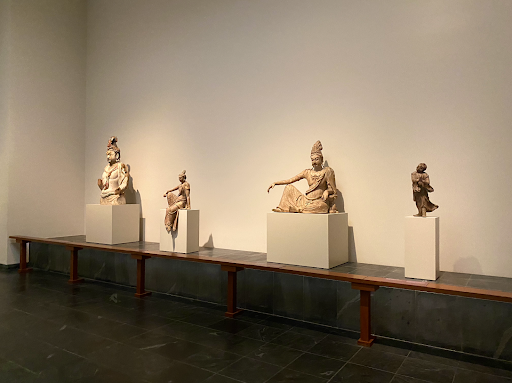In “Looking and Feeling,” columnist Weili Jin ’28 explores form, rhythm and emotional valence in works of art from across the globe.
Nestled in the Metropolitan Museum of Art’s galleries of Asian art is a sacred sanctuary housing Chinese Buddhist sculptures.
This sanctuary, Gallery 208, is designed and installed to evoke a meditative temple setting: a seventh-century lacquer Buddha sits in the center and rows of sculpted bodhisattvas grace each wall as natural light showers in from the skylight above. When I go to The Met, it’s both the first gallery I visit when I arrive and the final gallery I visit before I leave.

The sculptures housed in this room are among the finest examples of 7th- to 14th-century Chinese Buddhist art. Among them, however, one stands alone for its poised composure and air of grace.
The work is a bodhisattva dating to the Liao dynasty (907–1125 CE), meticulously carved from willow wood, once vibrantly adorned with pigments that are now faint. On his diadem headdress, we see a miniature representation of the Buddha sitting cross-legged above a lotus.
This iconography identifies him as Avalokiteshvara, the bodhisattva who embodies compassion. In China, Avalokiteshvara is known as “Guanyin” (观音). He’s often portrayed as androgynous, though has gradually been feminized; by the 12th century, for example, a Chinese princess becomes identified as one of the deity’s earthly incarnations.
In the medieval Chinese Buddhist tradition, a bodhisattva is someone who has achieved enlightenment, like a buddha, but rather than entering nirvana (loosely, paradise), they’ve opted to stay in our mortal world to guide others to do the same. They were regarded and venerated as altruistic deities.
By the 11th century, when this sculpture from The Met was made, Guanyin had become an immensely popular subject of Chinese devotion, glorified as a selfless bodhisattva who could offer compassion in times of need and despair.
This representation of Guanyin spoke to me instantaneously when I first encountered it in 2016. I remember being so struck by his calm disposition and relaxed posture. There’s a princely dignity and measured serenity in his pose: he’s seated upright, right hand perched on raised right knee, left hand resting on a rocky outcrop. His eyes are downcast and his lips gently pursed, giving the slightest hint of a smile.
The stylization of his physical appearance is counterpoised by the virtuosic tangible realism of his drapery, producing a figure that occupies a liminal space between the ideal and the real, the divine and the mortal. He feels at once approachable and aloof — not quite familiar, but within emotional reach. That tension sparks a delicate magic, an aura of mystique.
Guanyin’s posture here is evocatively termed his “Water-Moon” form (in Chinese, 水月观音). It implies that he’s resting in his personal paradise, the legendary Mount Potalaka, by a lotus pond in a forest of bamboo. He sits on a rocky ledge above the pond, contemplating the moon.
Praying to Guanyin in his water-moon manifestation, then, means praying to a compassionate divinity in deep attunement with nature and, by extension, with the cosmic order itself. I find this arrangement absolutely exquisite.
In its original context, this Water-Moon Guanyin might’ve been placed before a mural that visualized this idyllic setting. Far removed from that context, halfway around the globe in an American museum, we can only imagine the backdrop of his divine abode. Still, the atmospheric presence of this sculpture remains ever powerful and ever resonant, transcending boundaries of time and space.
This idea of temporality and spatiality also urges me to consider the past life of this statue, which, judging by its attribution to the Liao dynasty, likely took place in a northern Chinese temple. There, it would’ve held profound religious significance, watching over countless cycles of pain and pleasure, gratitude and repentance, joy and suffering. It’s poignant to consider just how many people might have stood, kneeled, sang, laughed and cried before this sacred image of Guanyin contemplating the moon.
Guanyin is, first and foremost, the bodhisattva of compassion. His demeanor exudes wisdom; his deeds promote peace. When in pain, he is there. When in need of serenity, he is there. When in search of stability, he is there.
In Gallery 208 of the Metropolitan Museum, I see all of that embodied in this masterwork of sculpture from ten centuries ago. Solace, serenity, stability and compassion — it all converges here in this ineffably elegant Water-Moon Guanyin that has survived the trials and tides of history for one thousand years and counting.
The symbolic presence and spiritual principle embodied in this bodhisattva lives on, I think, in the memory and imagination of those who see it. To me, this transcendent abstraction takes on even greater power than the physical work itself. It allows me to turn and return to this compassionate sculpture of a compassionate divinity far beyond The Met’s gallery walls, taking it with me wherever I go. In difficult times, it serves as an anchor of reference that I hold close. It’s timeless, ever enduring and ever resonant. It’s always here.
Editor’s Note: This article is a review and includes subjective thoughts, opinions and critiques.
